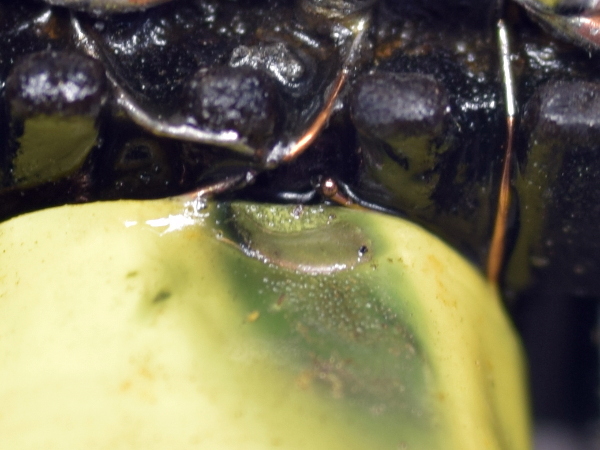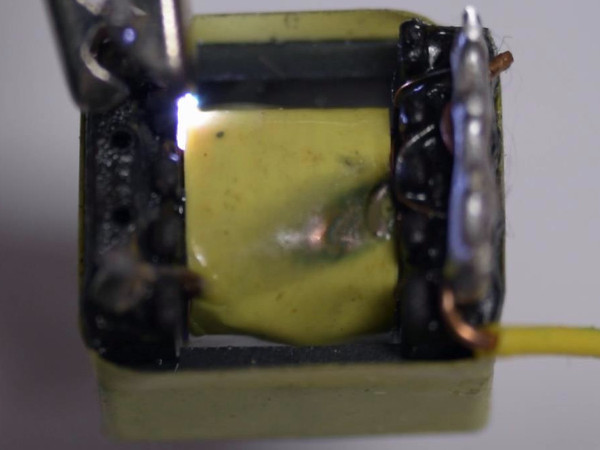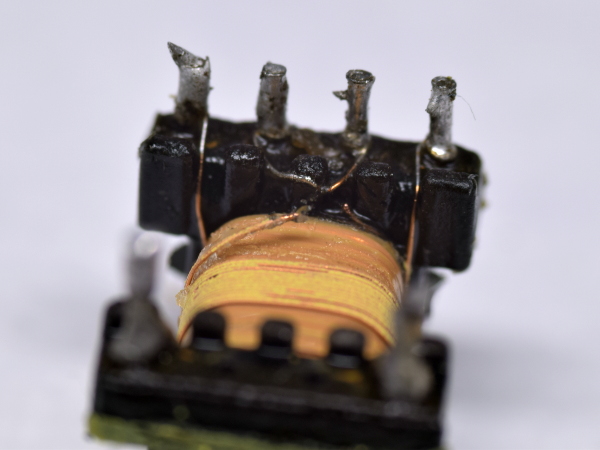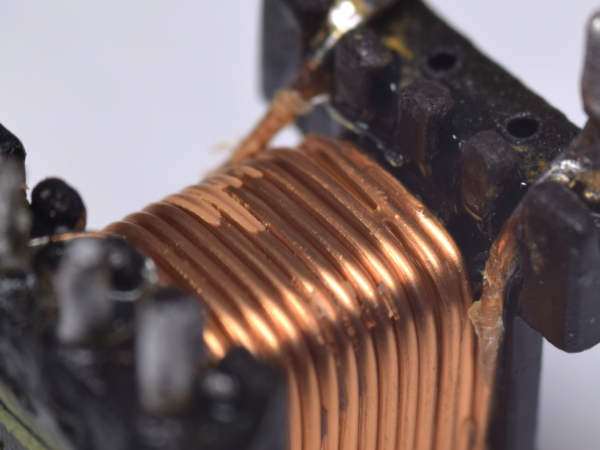Tom's Teardown: Two More Apple A1265 iPhone Charger Lookalikes
BDL1000 – Standby Power
The BDL1000 churns to life on as little as 6VAC at its input. But its output only reaches 5V under no-load condition at 12VAC. Where standby input power is concerned, it performs significantly worse than the Colorful. We measure 80mW on 115V and 100mW on 230V versus the Colorful’s sub-20mW in both scenarios.
If the MOSFET was supposed to reduce switching losses, it clearly isn’t happening under no-load condition.
MORE: Apple 5W Adapter Knock-offs: The Colorful A1265 Teardown
MORE: 10 Inexpensive Automotive USB Adapters, Tested
BDL1000 – Output Noise Waveform
A common issue with loosely regulated free-running circuits is that their operation varies substantially with voltage across the input capacitor. What makes it particularly bad here is that a 2.2µF capacitor charged to 162V stores only 29mJ worth of energy every 8ms or so. At 3W (2.5W out + losses), the input capacitor voltage is already yo-yoing between about 90V and 162V.
Another way to look at it is that if the circuit was actually capable of delivering 5V/1A, the input capacitor would be drained in roughly a quarter-cycle, making it fundamentally impossible to actually deliver continuous output.
I’m tempted to tack on a larger input capacitor and see how much it improves output current and line regulation ripples.
Get Tom's Hardware's best news and in-depth reviews, straight to your inbox.
MORE: Apple 5W Adapter Knock-offs: The Colorful A1265 Teardown
MORE: 10 Inexpensive Automotive USB Adapters, Tested
BDL1000 – Adapter Goes Poof!
While attempting to dial in my load as close to the maximum current before output dipped below 4.75V, the adapter quit on me in a brief pinkish-white flash of glory. Fortunately, it was safely contained within my glass jar and I caught the failure on video.
Given how the output current dropped moments before the failure, an intermittent contact in my DIY load may have caused it to cut out. The adapter may not have appreciated this. Then again, an actual load dump should have caused the output voltage to surge up, and my DC meter didn’t register such an event.
The input capacitor mod idea will have to wait, it appears.
MORE: Apple 5W Adapter Knock-offs: The Colorful A1265 Teardown
MORE: 10 Inexpensive Automotive USB Adapters, Tested
Toasty
Whatever happened to the adapter, it instantaneously vaporized the 10Ω input current-limiting resistor: its protective coating ripped open in the bottom-left corner, popped a chunk from the middle while cracking the surrounding coating and lightly scorching the surface in both places. It went out so quickly that the resistor body itself didn’t have time to get charred.
Had the resistor not been there to sacrifice itself, this (whatever it was) could have turned into a much longer and more energetic event.
MORE: Apple 5W Adapter Knock-offs: The Colorful A1265 Teardown
MORE: 10 Inexpensive Automotive USB Adapters, Tested
The Search For Fail
Probing the transistors in diode mode tells me that they appear to be fine. Doing the same across the rectifier bridge tells a similar story. But checking resistance between the transformer’s primary-side windings turns up a clue: probing all six possible terminal permutations revealed no continuity between any two pins. One hint as to what may have happened is that the transformer’s core got very hot.
My guess? The transformer core warmed up under high load, its magnetic permeability (its ability to concentrate magnetic fields) dropped due to temperature, it entered saturation (unable to store any more magnetic energy), and self-destructed from the subsequent over-current.
MORE: Apple 5W Adapter Knock-offs: The Colorful A1265 Teardown
MORE: 10 Inexpensive Automotive USB Adapters, Tested
BDL1000 – Isolation Withstand Test
Before ripping the transformer out to test it separately, let’s see how much voltage the circuit boards can take before arcing over across the primary-secondary boundary.
We get the first sparks at 1120VAC, which is exactly where I expected them to show up. Dialing back the voltage and bringing it back up produces the next sparks at 1381VAC, implying the earlier sparks may have been helped along by surface contamination that got burnt off. This is why maintaining sufficient creepage distances is safety-critical.
MORE: Apple 5W Adapter Knock-offs: The Colorful A1265 Teardown
MORE: 10 Inexpensive Automotive USB Adapters, Tested
Zappity-Zap
How would the primary winding failing cause the feedback winding to also go open-circuit? The answer became obvious after I ripped the transformer out to perform my transformer insulation test. You see, the primary and feedback winding wires cross each other near the transformer’s middle two pins. When the primary wire (top-left to bottom-right) broke near the feedback wire, or perhaps had a winding-to-winding arc-over, copper plasma vaporized the feedback wire along the way.
About two millimeters of the primary wire and maybe half a millimeter of the feedback wire sputtered away onto the winding insulation tape, giving it a slight copper sheen. Again, without the sacrificial resistor limiting arc energy, the damage may have been far more extensive.
MORE: Apple 5W Adapter Knock-offs: The Colorful A1265 Teardown
MORE: 10 Inexpensive Automotive USB Adapters, Tested
BDL1000 – Transformer Withstand Test
Since this transformer has already had an arc fault failure, I thought its insulation may have been compromised and that I’d get a very early failure here. Much to my surprise, the transformer actually withstood 3kVAC before arcing over between primary and secondary near the top secondary pin. In the end, it lands just 500V shy of a pass, albeit a dodgy one due to the lack of double-insulation between transformer terminals and the windings to prevent arcs where wires cross each other.
I have a sneaking suspicion that the failure was caused by the exact same sort of incomplete winding insulation coverage seen in my Colorful adapters’ tear-down.
MORE: Apple 5W Adapter Knock-offs: The Colorful A1265 Teardown
MORE: 10 Inexpensive Automotive USB Adapters, Tested
BDL1000 – Undressing
Removing the outer tape layer reveals seemingly intact feedback winding, apart from the piece of wire that got burnt off by the arc. There are no traces of what happened above the two layers of tape. Also, the feedback winding comes nowhere close to the secondary winding, which means the isolation failure is on a deeper layer.
Time to remove the feedback winding and look at the secondary winding under its tape...
MORE: Apple 5W Adapter Knock-offs: The Colorful A1265 Teardown
MORE: 10 Inexpensive Automotive USB Adapters, Tested
BDL1000 – Digging Deeper
Removing the feedback winding and the layer of beige-colored insulation tape separating it from the secondary uncovers a reasonably chunky winding. Can you spot where the arc came from in this picture? I can’t, but we know from the video that it came from the area near the secondary terminal to the right.
Let’s dig deeper to expose the insulation fault.
MORE: Apple 5W Adapter Knock-offs: The Colorful A1265 Teardown












